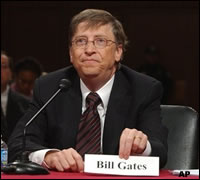
Not content with shaping education directly through schools, the biggest player in the school-reform movement has an eye on moving education policy.
The Bill & Melinda Gates Foundation has spent around $200 million a year on grants to elementary and secondary education. Now, the foundation is taking unprecedented steps to spend millions to influence the way the federal government distributes nearly $5 billion in “Race to the Top” grants to overhaul public schools.
President Barack Obama persuaded Congress to give him the money as part of the economic stimulus package so he could try new ideas to fix an education system that most agree is failing. The foundation is offering $250,000 apiece to help states apply, so long as they agree with the foundation’s approach.
Obama and the Gates Foundation share some goals that not everyone embraces: paying teachers based on student test scores, among other measures of achievement; charter schools that operate independently of local school boards; and a set of common academic standards adopted by every state.
Some argue that a private foundation shouldn’t partner with the government.
“When you team up with the government, you compromise your ability to be critical of the government, and sometimes you compromise your ability to do controversial and maybe unpopular things with your money,” said Chester E. Finn Jr., president of the Thomas B. Fordham Institute, an education think tank. The institute is among the many that have received money from the Gates Foundation.
Another concern is that as a private foundation, Gates doesn’t have to disclose the details of its spending as the government does.
The largest teachers’ unions dispute some of the goals shared by Obama and the foundation. They say student achievement is much more than a score on a standardized test and that it’s a mistake to rely so heavily on charter schools.
“Despite growing evidence to the contrary, it appears the administration has decided that charter schools are the only answer to what ails America’s public schools,” the National Education Association, the largest teachers’ union, said in comments about the grant competition submitted to the Education Department.
The NEA added: “We should not continue the unhealthy focus on standardized tests as the primary evidence of student success.”
The American Federation of Teachers submitted similar comments. Together the unions have 4.6 million members.
In spite of such objections, Education Secretary Arne Duncan welcomes the Gates Foundation’s involvement.
“The more all of us are in the game of reform, the more all of us are pushing for dramatic improvement, the better,” Duncan said in an interview with the Associated Press.
Duncan’s inner circle includes two former Gates employees. His chief of staff is Margot Rogers, who was special assistant to Gates’ education director. James Shelton, assistant deputy secretary, was a program director for Gates’ education division.
Rogers said she joined the administration because she was inspired by its goals of helping kids graduate from high school and finish college.
The administration has waived ethics rules to allow Rogers and Shelton to deal more freely with the foundation, but Rogers said she talks infrequently with her former colleagues.
Bill Gates said his foundation is not the government’s partner in the new Race to the Top grant program.
“It’s no secret the U.S. education system is failing,” Gates said. “We’re doing all kinds of experiments that are different. The Race to the Top is going to do many different ones. There’s no group-think.”
Gates stepped away last year from his daily role at Microsoft, the software company he co-founded, to focus on the work of his foundation.
Vicki Phillips, the Gates Foundation’s director of education, said it originally offered help to states and school districts that it was working with and that are in agreement with many of the foundation’s goals. She said the foundation shares Obama’s priorities and sees itself as part of a larger reform effort.
The foundation’s rising profile comes as the recession has gutted state and local budgets, which spend more money on education–roughly 35 percent–than anything else. Many states and districts can’t keep all their teachers on the payroll, let alone spend money on a high-stakes application for federal money that includes some 44 pages of rules.
In Minnesota, more than a dozen education department staffers are working with consultants from the McKinsey & Co. global consulting firm to prepare the state’s application, using about $250,000 in Gates Foundation money, spokesman Bill Walsh said.
When the foundation offered to help states apply for the grant money, it initially offered the $250,000 to only 15 states.
Officials in other states complained when they learned of the plan. The governors and chief school officers groups pressed the foundation to expand its offer, and it has now agreed to help any state that meets eight criteria, including a commitment to the common standards effort and the ability to link student data to teachers.
The foundation also is helping some districts that are eligible for a share of the money if they are working in partnership with nonprofit organizations, including the Gates Foundation.
Not all the states are willing to discuss the help from Gates or their applications for the federal grants. In more than half a dozen states, education officials did not return phone calls from AP seeking interviews about the applications.
Links:
Bill & Melinda Gates Foundation
- ‘Buyer’s remorse’ dogging Common Core rollout - October 30, 2014
- Calif. law targets social media monitoring of students - October 2, 2014
- Elementary world language instruction - September 25, 2014

